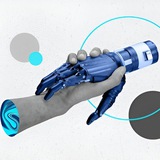شبکه عصبی دقیقاً چیه؟
🧠 شبکه عصبی یه مدل محاسباتیه که از ساختار مغز الهام گرفته. دادهها وارد لایه ورودی میشن، توی لایههای مخفی حسابی پردازش میشن (با تغییر وزنها و بایاسها) و در نهایت توی لایه خروجی جواب میگیریم.
مکانیزم یادگیریش هم ساده ولی عمیقه: مدل یه پیشبینی میکنه، خطاش اندازهگیری میشه، و بعد با الگوریتمهایی مثل پسانتشار خطا (Backpropagation) وزنها اصلاح میشن. تکرار همین چرخه باعث میشه شبکه کمکم هوشمندتر بشه.
🦴 @scopeofai | #concepts
🧠 شبکه عصبی یه مدل محاسباتیه که از ساختار مغز الهام گرفته. دادهها وارد لایه ورودی میشن، توی لایههای مخفی حسابی پردازش میشن (با تغییر وزنها و بایاسها) و در نهایت توی لایه خروجی جواب میگیریم.
مکانیزم یادگیریش هم ساده ولی عمیقه: مدل یه پیشبینی میکنه، خطاش اندازهگیری میشه، و بعد با الگوریتمهایی مثل پسانتشار خطا (Backpropagation) وزنها اصلاح میشن. تکرار همین چرخه باعث میشه شبکه کمکم هوشمندتر بشه.
A neural network is a computational system inspired by how our brains work. It consists of layers of artificial nodes—neurons—that process data step by step
Input layer: Receives raw data (e.g., images, numbers, text).
Hidden layers: Process that data through interconnected neurons, adjusting internal values called weights and biases to improve accuracy
Output layer: Generates a prediction or classification.
The network learns by making predictions, measuring how off they are using a loss function, and then tweaking those weights and biases
🦴 @scopeofai | #concepts
انواع شبکههای عصبی
⚱ همهی شبکهها یه شکل نیستن؛ هر معماری برای مسئلهای خاص طراحی شده:
🔹Feedforward (MLP): جریان یکطرفه داده. ساده و پایهای، ولی برای دستهبندی و پیشبینیهای معمولی خیلی کاربردیه
🔹CNN (Convolutional Neural Network): مخصوص بینایی ماشین. لایههای کانولوشن ویژگیهای تصویر رو خودشون استخراج میکنن؛ برای تشخیص چهره، اشیا و هر چیزی که پای پیکسل وسطه، فوقالعادهست
🔹RNN (Recurrent Neural Network): مناسب دادههای ترتیبی. چون حافظه داخلی داره، میتونه وابستگی بین دادههای پشتسرهم رو بفهمه
🔹DNN (Deep Neural Network): همون شبکههای عمیق با چندین لایه مخفی. هرچی شبکه عمیقتر باشه، قابلیت یادگیری الگوهای پیچیدهتر هم بیشتر میشه
( بعدا به اینا عمیقتر هم میپردازیم)
🦴 @scopeofai | #concepts
⚱ همهی شبکهها یه شکل نیستن؛ هر معماری برای مسئلهای خاص طراحی شده:
🔹Feedforward (MLP): جریان یکطرفه داده. ساده و پایهای، ولی برای دستهبندی و پیشبینیهای معمولی خیلی کاربردیه
🔹CNN (Convolutional Neural Network): مخصوص بینایی ماشین. لایههای کانولوشن ویژگیهای تصویر رو خودشون استخراج میکنن؛ برای تشخیص چهره، اشیا و هر چیزی که پای پیکسل وسطه، فوقالعادهست
🔹RNN (Recurrent Neural Network): مناسب دادههای ترتیبی. چون حافظه داخلی داره، میتونه وابستگی بین دادههای پشتسرهم رو بفهمه
🔹DNN (Deep Neural Network): همون شبکههای عمیق با چندین لایه مخفی. هرچی شبکه عمیقتر باشه، قابلیت یادگیری الگوهای پیچیدهتر هم بیشتر میشه
( بعدا به اینا عمیقتر هم میپردازیم)
Different architectures exist to tackle various challenges. The main ones:
🔹Feedforward Neural Networks (MLPs): Data moves straight from input to output. Great for general tasks like classification and pattern recognition
🔹Convolutional Neural Networks (CNNs): Built for vision tasks—images, object detection, segmentation. They use convolutional layers to automatically extract features, making them incredibly efficient
🔹Recurrent Neural Networks (RNNs): Designed for sequential data—text, speech, time series. They "remember" past info via feedback loops. LSTMs and GRUs improve their ability to handle long-range dependencies
🔹Deep Neural Networks (DNNs): Simply NNs with multiple hidden layers—depth allows learning highly complex patterns
🦴 @scopeofai | #concepts
کاربردهای شبکههای عصبی
تقریباً در تمام حوزههای هوش مصنوعی ردپای شبکههای عصبی دیده میشه:
🔅 بینایی ماشین: از فیلترهای اینستاگرام تا سیستمهای تشخیص چهره و ماشینهای خودران.
🔉 پردازش زبان طبیعی: ترجمه ماشینی، چتباتها، مدلهای مولد متن.
🎙پردازش صوتی: تشخیص گفتار، تولید موسیقی یا صدا با هوش مصنوعی.
⏳ تحلیل سریهای زمانی: پیشبینی بازارهای مالی، تحلیل روندها، تشخیص ناهنجاریها.
🦴 @scopeofai | #concepts
تقریباً در تمام حوزههای هوش مصنوعی ردپای شبکههای عصبی دیده میشه:
🔅 بینایی ماشین: از فیلترهای اینستاگرام تا سیستمهای تشخیص چهره و ماشینهای خودران.
🔉 پردازش زبان طبیعی: ترجمه ماشینی، چتباتها، مدلهای مولد متن.
🎙پردازش صوتی: تشخیص گفتار، تولید موسیقی یا صدا با هوش مصنوعی.
⏳ تحلیل سریهای زمانی: پیشبینی بازارهای مالی، تحلیل روندها، تشخیص ناهنجاریها.
3) What Are Neural Networks Used For?
Neural networks are everywhere:
Image recognition & computer vision — think facial recognition, object detection, video analysis (thanks to CNNs)
Language & audio tasks — including speech recognition, translation, text generation using RNNs and more modern variants like transformers
Predictive & time-series modeling — especially in areas like finance, forecasting, or any data that needs pattern detection
Everyday tech — voice assistants, self-driving cars, logistics, security cameras—you name it
🦴 @scopeofai | #concepts
محدودیتها و چالشها
قدرت بالا به معنی بینقص بودن نیست:
▫️داده و محاسبات سنگین: شبکههای عمیق برای آموزش نیاز به دیتاستهای بزرگ و GPU/TPU دارن.
▫️جعبه سیاه بودن: تصمیمگیری شبکه قابل توضیح نیست. شفافیت (Explainability) همچنان یه چالش جدیه.
▫️پیچیدگی در آموزش: مسائلی مثل vanishing gradient یا انتخاب معماری درست، کار رو سخت میکنن.
▫️Overfitting: وقتی داده کافی یا متنوع نداشته باشی، مدل به جای یادگیری الگو، فقط دادهی آموزشی رو حفظ میکنه
🦴 @scopeofai | #concepts
قدرت بالا به معنی بینقص بودن نیست:
▫️داده و محاسبات سنگین: شبکههای عمیق برای آموزش نیاز به دیتاستهای بزرگ و GPU/TPU دارن.
▫️جعبه سیاه بودن: تصمیمگیری شبکه قابل توضیح نیست. شفافیت (Explainability) همچنان یه چالش جدیه.
▫️پیچیدگی در آموزش: مسائلی مثل vanishing gradient یا انتخاب معماری درست، کار رو سخت میکنن.
▫️Overfitting: وقتی داده کافی یا متنوع نداشته باشی، مدل به جای یادگیری الگو، فقط دادهی آموزشی رو حفظ میکنه
What Are the Limitations of Neural Networks?
As powerful as they are, neural networks aren’t perfect:
▫️Data-hungry & compute-intensive: They need massive datasets and hardware (GPUs, TPUs) to train well
▫️Opaque “black box” nature: Often hard to understand how they reach a decision—explainability is a growing concern
▫️Training complexity: Deep or recurrent networks can suffer from problems like vanishing gradients, and setting up architectures and training regimes is non-trivial
▫️Overfitting & generalization risk: Without enough diverse data, models can learn “noise” instead of true patterns and fail on new data
🦴 @scopeofai | #concepts
